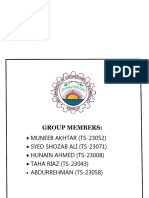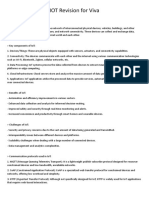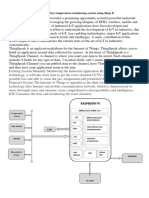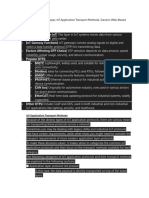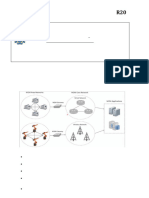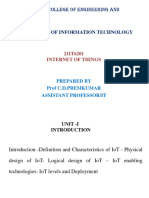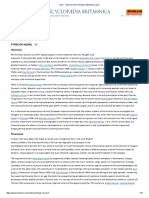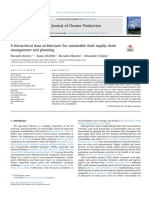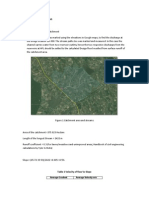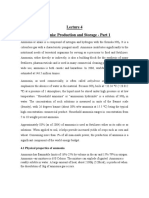0 ratings0% found this document useful (0 votes)
20 viewsIoT&PP-Unit 3
IoT&PP-Unit 3
Uploaded by
santhiThe document discusses standards and frameworks for connecting physical devices to the internet and web. It describes the World Wide Web of Things (WoT) and compares it to the Internet of Things (IoT). It then outlines several standards organizations and their work related to connecting sensors, devices, and industrial systems to the web.
Copyright:
© All Rights Reserved
Available Formats
Download as PPTX, PDF, TXT or read online from Scribd
IoT&PP-Unit 3
IoT&PP-Unit 3
Uploaded by
santhi0 ratings0% found this document useful (0 votes)
20 views65 pagesThe document discusses standards and frameworks for connecting physical devices to the internet and web. It describes the World Wide Web of Things (WoT) and compares it to the Internet of Things (IoT). It then outlines several standards organizations and their work related to connecting sensors, devices, and industrial systems to the web.
Copyright
© © All Rights Reserved
Available Formats
PPTX, PDF, TXT or read online from Scribd
Share this document
Did you find this document useful?
Is this content inappropriate?
The document discusses standards and frameworks for connecting physical devices to the internet and web. It describes the World Wide Web of Things (WoT) and compares it to the Internet of Things (IoT). It then outlines several standards organizations and their work related to connecting sensors, devices, and industrial systems to the web.
Copyright:
© All Rights Reserved
Available Formats
Download as PPTX, PDF, TXT or read online from Scribd
Download as pptx, pdf, or txt
0 ratings0% found this document useful (0 votes)
20 views65 pagesIoT&PP-Unit 3
IoT&PP-Unit 3
Uploaded by
santhiThe document discusses standards and frameworks for connecting physical devices to the internet and web. It describes the World Wide Web of Things (WoT) and compares it to the Internet of Things (IoT). It then outlines several standards organizations and their work related to connecting sensors, devices, and industrial systems to the web.
Copyright:
© All Rights Reserved
Available Formats
Download as PPTX, PDF, TXT or read online from Scribd
Download as pptx, pdf, or txt
You are on page 1of 65
ITM05
IoT & Python Programming
UNIT - III
WoT versus IoT
• The Internet is the term used to identify the massive interconnection
of computer networks around the world.
• It refers to the physical connection of the paths between two or more
computers.
• The World Wide Web is the general name for accessing the Internet
via HTTP, thus www.anything.something.
• It is just one of the connection protocols that is available in the
Internet, and not the only one.
Some of the WoT applications are.
◾ Arduino (http://arduino.cc/en/): Arduino can sense the environment by receiving
input from a variety of sensors and can affect its surroundings by controlling
lights, motors, and other actuators.
◾ Japan Geiger Map (http://japan.failedrobot.com/): this map visualizes crowd-
sourced radiation Geiger counter readings from across Japan.
◾ Nanode (http://nanode.eu/): Nanode is an open-source Arduino-like board that
has built-in web connectivity. It is a low-cost platform for creative development of
webconnected ideas.
◾ The National Weather Study Project (http://nwsp.ntu.edu .sg/sensormap/): NWSP
is a large-scale environmental study project deploying hundreds of mini weather
stations in schools throughout Singapore.
◾ AgSphere: TelemetryWeb.com is launching AgSphere, a new platform that takes
the complexity and pain out of connecting agricultural technology products to the
web quickly and at low cost. Manufacturers of agricultural equipment can build
web-connected solutions that increase margins, reduce risk, and improve
efficiencies for farmers by harvesting information from the farm
Two Pillars of the Web
Architecture Standardization for WoT
Platform Middleware for WoT
• Platform middleware (also called application frameworks, or sometimes,
directly, the three-tiered application server) are frameworks at the application
level, or at the “M” level of the DCM (direct, change, manage) value chain.
• One main goal of platform middleware is to bring the IoT applications
(including Intranet of Thongs and Extranet of Things) to the World Wide Web.
• According to the WoT/IoT vision, everyday objects such as domestic
appliances, actuators, and embedded systems of any kind will be connected
with each other and with the Internet.
• These will form a distributed network with sensing capabilities that will allow
unprecedented market opportunities, spurring new services, including energy
monitoring and control of homes, buildings, industrial processes, and so forth.
Standardisation for M2M
• The European Telecommunications Standards Institute (ETSI’s) Global
Standards Collaboration (GSC) M2M Standardization Task Force
(MSTF) considers M2M as any automated data exchange between
machines including virtual machines such as software applications
without or with limited human intervention
• An M2M system is described by clearly structured and specified
network transitions, software and hardware interfaces, protocols,
frameworks, and so forth shall ensure the interoperability of all
system elements.
The key elements of the ETSI M2M architecture are,
◾ M2M device: A device capable of replying to requests or transmitting data contained
within those devices autonomously.
◾ M2M area network (MAN): A network providing connectivity between M2M devices
and gateways. Examples of M2M area networks include personal area network
technologies such as (wireless) IEEE 802.15, short range devices (SRD), UWB, ZigBee,
Bluetooth, and others, and (wired) CanBus, Modbus, KNX, LonWorks, PLC (Power
Line Communication), and others.
◾ M2M gateway: The use of M2M capabilities to ensure that M2M devices interwork
and interconnect to the communications networks.
◾ M2M communications networks: Communications networks between M2M
gateways and M2M applications servers. They can be further broken down into
access, transport, and core networks. Examples include xDSL, PLC, satellite, LTE,
GERAN, UTRAN, eUTRAN, W-LAN, WiMAX, and others.
◾ M2M application server: The middleware layer where data goes through the various
application services and is used by the specific business-processing engines.
The M2M platform middleware normally covers the layers from M2M gateway to the
M2M application server.
Frameworks for WSN
• The Open Geospatial Consortium, Sensor Web Enablement (OGC
SWE) standardization effort is intended to be a revolutionary
approach for exploiting web-connected sensors such as flood gauges,
air pollution monitors, satellite-borne earth-imaging devices, and so
forth.
• The goal of SWE is creation of web-based sensor networks to make all
sensors and repositories of sensor data discoverable, accessible, and
where applicable, controllable via the World Wide Web.
SWE is a suite of standard encodings and web services that enable the
following:
◾ Discovery of sensors, processes, and observations
◾ Tasking of sensors or models
◾ Access to observations and observation streams
◾ Publish–subscribe capabilities for alerts
◾ Robust sensor system and process descriptions
The following web service specifications have been produced by the
OGC SWE Working Group:
◾ Sensor observation service—standard web interface for accessing
observations
◾ Sensor planning service—standard web interface for tasking sensor
systems and model and requesting acquisitions
◾ Sensor alert service—standard web interface for publishing and
subscribing to sensor alerts
◾ Web notification service—standard web interface for asynchronous
notification
Standards for SCADA
• ISO 16100-1:2009, one of the components of ISO 16100 standard for
industrial automation systems and controls–IT convergence
integration, specifies a framework for the interoperability of a set of
software products used in the manufacturing domain and to facilitate
its integration into a manufacturing application. This framework
addresses information exchange models, software object models,
interfaces, services, protocols, capability profiles, and conformance
test methods.
• ANSI/ISA-95 is an international standard for developing an automated
interface between enterprise and control systems. This standard has
been developed for global manufacturers.
The five parts of the ISA-95 standard are as follows:
◾ ANSI/ISA-95.00.01-2000, Enterprise-Control System Integration, Part
1: Models and Terminology
◾ ANSI/ISA-95.00.02-2001, Enterprise-Control System Integration, Part
2: Object Model Attributes
◾ ANSI/ISA-95.00.03-2005, Enterprise-Control System Integration, Part
3: Models of Manufacturing Operations Management
◾ ISA-95.04, Object Models & Attributes, Part 4: Object models and
attributes for Manufacturing Operations Management
◾ ISA-95.05, B2M Transactions, Part 5: Business to Manufacturing
Transactions
SmartProducts consortium resulted in a platform that supports stand-alone or
integrated, context-aware products for a range of application scenarios. It
developed a scientific and technological basis for building smart products with
embedded “proactive knowledge.” Details about the different components of the
middleware platform can be found in the following categories:
◾ Interaction: components for supporting the interaction between user and smart
products
◾ Communication: components for supporting the information exchange and
cooperation between different smart products
◾ Context: components for sensing, processing, and distributing context
information
◾ Proactive knowledge base: components for handling the knowledge of a smart
product
◾ Secure distributed storage: components for storing knowledge of a smart
product in a secure and distributed way
◾ Tools: tools for developing smart products, such as for automatically extracting
relevant information from manuals, editors
Extensions on RFID Standards
• The EPCglobal-defined radio-frequency identification (RFID)
architecture and frameworks are probably the most comprehensive and
complete standards among the four pillar segments of IoT.
• The goal of CASAGRAS (Coordination and Support Action for Global
RFID-related Activities and Standardization) was to provide a framework
of foundation studies to assist the European Commission and the global
community in defining and accommodating international issues and
developments concerning RFID with particular reference to the
emerging Internet of Things.
• BRIDGE (Building Radio-frequency IDentification solutions for the Global
Environment) is a European Union–funded three-year integrated
project addressing ways to resolve the barriers to the implementation
of RFID in Europe, based upon GS1 EPCglobal standards, by extending
the EPC network architecture.
Contd.
The Cross UBiQuitous Platform (CUBIQ) project, aims to provide an
integrated horizontal platform that offers unified data access, processing,
and service federation on top of existing, heterogeneous IoT-architecture-
based ubiquitous services. A unified data model was defined using USDL
(universal service definition language). The CUBIQ architecture consists of
three layers (and serverless real-time location search with RFID tags is an
application example of the CUBIQ project)
Mobile terminals with RFID tag reader collect RFID tag info and record
location.
The mobile terminals are connected via the core CUBIQ infrastructure
and share RFID tag information.
Observers can search RFID tag information to estimate the location of
target person.
Unified Multitier WoT Architecture
Apart from the standard efforts such as the ETSI, 3rd Generation Partnership
Project (3GPP), and Open Mobile Alliance (OMA), many research projects and
industrial products aim to define and build a common middleware platform
for WoT/IoT applications.
• NiagaraAX is a software framework (http://www.neopsis
.com/cms/en/solutions/niagara/) product and development environment
that solves the challenges associated with building device-to-enterprise
applications and distributed Internetenabled automation systems.
• It introduced the concept of a software framework that normalize the data
and behavior of diverse devices, regardless of manufacturer or
communication protocol, to enable the implementation of seamless,
Internet-connected, web-based systems.
• Data from diverse device systems are transformed into uniform software
components, that form the foundation for building applications to manage
The NiagaraAX highlights are:
◾ New graphics presentation framework and graphic development tool
◾ Comprehensive library of control objects
◾ New data archive model and flexible archive destinations
◾ New alarming capabilities that provides better visualization and user
experience
◾ Reporting and business intelligence supports
◾ Open driver development toolkit
◾ Open application programming interfaces (APIs) for developers
• FI-WARE of the European Union’s Future Internet Core Platform
project aims to create a novel service infrastructure.
• This infrastructure will bring significant and quantifiable
improvements in the performance, reliability, and production costs
linked to Internet applications,
• The reference architecture of the FI-WARE platform is structured
along a number of technical chapters:
◾ Cloud Hosting
◾ Data/Context Management
◾ IoT Services Enablement
◾ Applications/Services Ecosystem and Delivery Framework
◾ Security
◾ Interface to Networks and Devices
SOA/EAI versus SODA/MAI
• WoT/IoT applications should inherit and enhance the existing data formats and
protocols, and the matching software frameworks to build platform middleware for
WoT applications.
• SOAP (simple object access protocol), is a protocol framework specification for
exchanging structured information in the implementation of web services in
computer networks.
• It relies on XML for its message format, and other application layer protocols like
hypertext transfer protocol (HTTP), simple mail transfer protocol (SMTP), and Java
messaging services (JMS).
• REST (representational state transfer interface) is a lightweight SOAP. RESTful
applications maximize the use of the preexisting, well-defined interface and other
built-in capabilities provided by the chosen network protocol, and minimize the
addition of new application-specific features on top of it.
• REST also attempts to minimize latency and network communication, while at the
same time maximizing the independence and scalability of component
implementations.
• REST is a better framework protocol for MTCbased WoT/IoT applications.
• CoAP (constrained application protocol) is a specialized RESTful
transfer protocol for use with constrained networks and nodes for
M2M applications such as smart energy and building automation.
• CoAP, provides the REST method/response interaction model
between application endpoints, supports built-in resource discovery,
and includes key web concepts such as URIs and content types.
• CoAP easily translates to HTTP for integration with the web while
meeting specialized requirements such as multicast support, very low
overhead, and simplicity for constrained environments.
• SOAP, REST, and CoAP are standard technologies for B2B like
integration of systems on the Internet at the M2M/IoT
communication networks layer.
Enterprise Service Bus
• The ESB technology can be used for IoT application integration within
an intranet or extranet, and it can also be used or extended to work
over the Internet.
• The JCA (Java Connector Architecture) is another good approach for
WoT data collection and integration based on connectors or adaptors
(the .NET architecture also has adaptors).
• EAI and B2B seem related but they vary radically in their details. The
first is entirely within a single administrative domain. If a new
protocol does not work perfectly, it can be ripped out and replaced.
• In the cross-business environment, ripping it out affects customers,
who may have no incentive to upgrade to the new protocol and will
be annoyed if it changes constantly.
• A service-oriented architecture (SOA) is a set of principles and
methodologies for designing and developing software in the form of
interoperable services, usually over the Internet.
• SOA requires metadata (unified WoT architecture also needs
metadata) in sufficient detail to describe not only the characteristics
of the promised services but also the data that drives them.
• The web services description language typically describes the
services, while the SOAP protocol describes the communication
protocols.
• SOA can be implemented using any service-based technology, such as
REST, CORBA, or Jini, and any programming language.
• The combination of the existing SOA (across Internet and extranet)
and EAI (intranet) technologies is a good foundation for WoT/IoT
applications.
• EAI can be extended for MAI (M2M application integration) within an
intranet. SOA can be used for WoT/IoT integration over the Internet
and extranet.
• Service-oriented device architecture (SODA) is proposed to enable
device connection to an SOA.
• The core of the SODA standard is the DDL (device description
language) based on XML encodings. DDL classifies devices into three
categories: sensors, actuators, and complex devices.
• The ATLAS platform of University of Florida is an implementation of
the SODA standard.
SODA Architecture
OSGi: The Universal Middleware
• The OSGi (Open Services Gateway initiative framework) is a module system and
service platform for the Java programming language that implements a complete
and dynamic component model.
• Using OSGi, applications or components (coming in the form of bundles for
deployment) can be remotely installed, started, stopped, updated, and uninstalled
without requiring a reboot.
• The OSGi specifications have moved beyond the original focus of service gateways
and are now used in applications ranging from mobile phones to the open-source
Eclipse IDE.
• Other application areas include automobiles, industrial automation, building
automation, PDAs, grid computing, entertainment, fleet management, and
application servers.
• OSGi is a universal middleware and play an important role, as a unified multitiered
middleware architecture, in building WoT/IoT applications in many vertical
segments.
OSGi architecture
M2M Platform Middleware
WoT Framework Based on Data Standards
• The platform middleware of WoT/IoT can itself be multitiered, just like
the multitiered application servers for web applications.
• An unified multitiered IoT middleware can be categorized as having
layers as shown in Figure.
• The following additional functionalities and tools are added to IoT
middleware:
◾ Drag-and-drop/WYSIWYG (what you see is what you get) graphics and
animation development and deployment tools with embedded scripts; RAD
tools without programming
◾ BPM/rules engine (no programming required)-based IoT event/alert handling
and actions
◾ M2M gateway, communication adaptors, open and standard API, real-time
databases, and so forth
Multitiered WoT/IoT Middleware
Unified Multitiered WoT Application Architecture Framework
The multitiered architecture is summarized as follows:
◾ Application framework SES (smart enterprise suite)
◾ The IoT platform middleware based on application server (container)
◾ IoT services bus based on ESB (REST/SOAP/MQ/JMS, etc.) and unified
XML data format and protocol
◾ IoT adaptor based on the JCA
◾ The back end of IoT hosted by cloud infrastructure and provides IoT
cloud (MAI or XaaS) services
◾ The different devices or sensors of four pillars are connected via the
IoT gateways to the IoT bus.
• To summarize, many individual standards development organizations
want to incorporate existing standards into a unified conceptual
framework as much as possible,
• These organizations prefer to identify and fill gaps and to integrate
what already exists into the unified horizontal framework.
• It is impossible, or at least undesirable, to try to define new physical
layer technologies, networking layer protocols, or platform
middleware-based application frameworks for every current or future
potential WoT/M2M application.
• Different vertical applications will optimize for individual cost and
functionality requirements, while a standardized service layer will
facilitate cross-vertical application development.
WoT Portals and Business Intelligence
• A web portal (collection of mini web applications, called portlets) or
links page is a website that functions as a point of access to
information in the World Wide Web.
• A portal presents information from diverse sources in a unified way.
• Examples of public web portals include Yahoo, AOL, Excite, MSN, and
more recently, iGoogle.
• Apart from the standard search engine feature, web portals offer
other services such as e-mail, news, stock prices, information,
databases, and entertainment.
• There are two broad categorizations of portals: horizontal portals,
which cover many areas, and vertical portals, which are focused on
one functional area.
• As intranets grew in size and complexity, webmasters were faced with
increasing content and user management challenges.
• Users wanted personalization and customization.
• EIPs (enterprise information portals) also became common after the
public portals.
• EIP solutions can also include workflow management, collaboration
between work groups, and policy-managed content publication.
• Most can allow internal and external access to specific corporate
information using secure authentication or single sign-on.
• Standards are being developed to allow the interoperability of
portlets across different portal platforms.
• On the other hand, there is a need for a set of ontologies to connect sensor data
and sensing information with meaning.
• Semantic sensor networks are being currently developed.
• Additionally, real-time extension of the semantic sensor web concept is being
developed, called Sensor Wiki.
• In a sensor Wiki, one or more sensors contribute real-time information as Wiki
pages with suitable themes and formats useful to prospective Sensor Wiki users.
• Sensor Wiki users can look up information about objects, events, or places of
interest interactively.
• They can also add intelligent interpretations of what they observe, use sensor
tasking to add to the content to improve accuracy, or even develop the overall
scene to offer situation assessment on a proactive basis.
• Others might want to record such sensor streams and related information as part
of a larger objective such as future planning, training, or simply record keeping for
historical purposes, and make it available to a specific community or an individual.
• When enormous amount of data are collected in a IoT system, data
mining can be conducted to acquire business intelligence (BI) and
help decision support.
• BI technologies provide historical, current, and predictive views of
business operations.
• Common functions of BI technologies are extract, transform, and load
as well as reporting, online analytical processing, analytics, data
mining, process mining, complex event processing, business
performance management, benchmarking, text mining, predictive
analytics, and so on.
• For example, in many SCADA applications, BI is widely used.
• SCADA software vendors provide a number of relevant products such
as CitectSCADA Reports, Wonderware Intelligence, Acumence Plant
Analytics Server, and others.
• Also, a BI analytics of data from a fleet management system in China’s
truck/bus industry reveals that fuel usage can differ as much as 15
percent due to driver behavior for the same truck, route, and mileage.
CLOUD OF
THINGS
• Cloud computing provides computation, software, data access, and
storage services that do not require end-user knowledge of the
physical location and configuration of the system that delivers the
services.
• Details are abstracted from end-users, who no longer have the need
for expertise in, or control over, the technology infrastructure “in the
cloud” that supports them.
Build infrastructure solutions with Azure
IaaS services and products
• Compute. Access cloud compute capacity, virtualisation and scale on
demand—and only pay for the resources you use.
• Storage. ...
• Networking. ...
• Security. ...
• Management. ...
• Azure Virtual Desktop. ...
• Hybrid cloud solutions. ...
• High-performance computing (HPC)
Platform as a Service (PaaS)
• Platform as a Service (PaaS) is a complete cloud environment that
includes everything developers need to build, run, and manage
applications
• Azure provides
• Middleware, development tools, business intelligence (BI) services,
database management systems, and more. PaaS is designed to
support the complete web application lifecycle: building, testing,
deploying, managing, and updating.
• Software as a service (SaaS) allows users to connect to and use cloud-
based apps over the Internet. Common examples are email,
calendaring, and office tools (such as Microsoft Office 365)
• SaaS provides a complete software solution that you purchase on a
pay-as-you-go basis from a cloud service provider.
Grid/SOA and Cloud Computing
• Much like the Internet of Things, the technological foundation of cloud
computing is distributed computing based on communication
networks.
• One of the most directly related works is the use of cluster of
workstations (COWs) and networks of workstations.
• Virtualization is another important concept often mentioned in the
cloud computing context.
• There are two sides of the virtualization coin: single system
virtualization (SSV, i.e., one-to-many virtualization) and multisystem
virtualization (MSV, i.e., many-to-one virtualization).
• The purpose of SSV is to simulate multiple computers on top of one
computer—run multiple operating systems on one computer hardware
to enable maximum usage of the ever-increasing power of a single
computer such as a PC and increase efficiency of overall resources.
• On the other hand, many-to-one virtualization is the foundation of
cloud computing.
• MSV refers aggregately to the use of the aforementioned distributed
and parallel clustering technologies such as COW, high-performance
computing (HPC), grid computing, high-throughput computing, high-
availability computing, and so forth to build a single, gigantic, parallel
virtual computer or a single centralized service-providing virtual
resource that serves many users for a plethora of applications.
• Figure below shows the Many-to-one virtualization as the foundation
of cloud computing
• The computing and storage resource are delivered to the end users using
SOA (including SOAP or REST-based web services, SaaS, EAI, etc.) via the
Internet, sometimes via intranet and extranet for private cloud
applications.
• Many of the technologies and protocols of the SOA standard stack can
be used in all of the three layers: IaaS, PaaS, and SaaS.
• To summarize, cloud computing is the fusion of grid computing and SOA
technologies to provide everything as utility-style services,
• It is a large-scale distributed computing paradigm that is driven by
economies of scale, in which a pool of abstracted, virtualized,
dynamically-scalable, managed computing power, storage, platforms,
and services are delivered on demand to external customers over the
Internet.
Cloud computing is the fusion of grid and
SOA
Cloud Middleware
• The cloud computing system is also a multitiered architecture built on
a middleware as shown.
• Grid computing is the foundation of cloud computing infrastructure,
so grid middleware is the basis of IaaS middleware.
• In addition, the IaaS middleware part of cloud middleware may
include components such as system management, network
management, billing and operation support systems, provision,
configuration, automation, orchestration, service level agreement
(SLA) management, and so on.
• From the distributed enterprise computing standpoint, almost all of
the EAI and business-to-business (B2B) middleware are needed to
build cloud computing systems for enterprise and commercial
applications.
• They all are part of cloud middleware, particularly part of the PaaS
middleware. Multitenancy is one of the basic functions of PaaS
middleware, and the multitenant efficiency functionalities of a PaaS
platform are implemented in a traditional middleware such as the
three tiered application servers as shown in the figure below.
PaaS and cloud middleware
• The PaaS middleware is often referred to as the cloud middleware
that underpins and supports the SaaS applications.
• The more middleware is shared, the cloud systems scale to larger
numbers of tenants and with lower operational costs.
• To summarize, the cloud middleware consists of two kinds of
middleware—IaaS and PaaS middleware—and their relation is shown
in Figure below.
• SaaS are not middleware, they are applications on top of middleware.
Cloud Middleware
Cloud Standards
• Cloud computing is a model for enabling ubiquitous, convenient,
ondemand network access to a shared pool of configurable
computing resources (e.g., networks, servers, storage, applications,
and services) that can be rapidly provisioned and released with
minimal management effort or service provider interaction.
• This cloud model is composed of the following:
◾ Three service models: IaaS, PaaS, and SaaS
◾ Four deployment models: private cloud, public cloud, community cloud, and
hybrid cloud
◾ Five essential characteristics: on-demand self-service, broad network access,
resource pooling, rapid elasticity, and measured service
Electronics and Telecommunications Research Institute (ETRI) of Korea
proposed to address standards on nine aspects.
◾ Definition, taxonomy, terminologies
◾ Provisioning model
◾ Business process
◾ Security
◾ Interoperability
◾ Legality
◾ Environmental issues
◾ Architecture
◾ Availability
Table below lists some of the cloud computing standardization
organizations and their websites.
The following are some of the works done by those standards organizations:
◾ NIST: Working definition of cloud computing
◾ Distributed Management Task Force: Open Virtualization Format, Open Cloud Standards Incubator, DSP-IS0101 Cloud
Interoperability White Paper V1.0.0
◾ Cloud Management Working Group: DSP-IS0102 Architecture for Managing Clouds White Paper V1.0.0, and DSP-IS0103 Use
Cases and Interactions for Managing Clouds White Paper V1.0.0
◾ European Telecommunications Standards Institute: TC cloud definition
◾ Standards Acceleration to Jumpstart Adoption of Cloud Computing: 25 use cases
◾ Open Cloud Consortium: Open Cloud Testbed, Open Science Data Cloud, benchmarks, reference implementation
◾ The Cloud Computing Interoperability Forum: framework/ ontology, semantic web/resource description framework, unified
cloud interface
◾ The Open Group: SOA, The Open Group Architecture Framework
◾ Association for Retail Technology Standards: Cloud Computing White Paper V1.0
◾ TM Forum: Cloud Services Initiative, Enterprise Cloud Leadership Council Goals, Future Collaborative Programs, BSS/OSS/SLA
◾ ITU-T FG Cloud: Introduction to the Cloud Ecosystem: Definitions, Taxonomies and Use Cases;
◾ Global Inter-Cloud Technology Forum: Japan, Interoperability
◾ Cloud Standards Coordination: Standards Development Organization Collaboration on Networked Resources Management
◾ Open Cloud Manifesto (http://www.opencloudmanifesto .org/)
◾ Open Grid Forum: Open Cloud Computing Interface, Open Grid Services Architecture
◾ Cloud Security Alliance: Security Guidance for Critical Areas of Focus in Cloud Computing, Cloud Controls Matrix, Top Threats to
Cloud Computing, CloudAudit
◾ Storage Networking Industry Association: Cloud Storage Technical Work Group, Cloud Data Management Interface
Cloud Providers and Systems
• In short years, cloud computing has gone from being a quaint
technology to being a major catchphrase.
• There are many forecasts about market size of cloud computing.
• For example, Gartner estimated that, among the three SPI segments,
SaaS generates most of the revenue, because it directly creates value
for the end users.
• IaaS helps reduce the costs of organizational users, which has the
fastest growth.
• Gartner predicts the change of revenue on percentage among the
three SPI segments between 2010 (SaaS: 72%, PaaS: 26%, IaaS: 2%)
and 2014 (SaaS: 61%, PaaS: 36%, IaaS: 3%).
• There are many top 10, top 20, and top 50 listings of cloud providers
on the web that can be easily found with Google search.
• The cloud computing boom has brought a surge of opportunity to the
open-source world.
• Open-source developers and users are taking advantage of these
opportunities.
• Many open-source applications are now available on a SaaS basis.
• Other open-source projects have taken the steps necessary to make
them easy to use in the cloud, for example, by making preconfigured
images available through Amazon Web Services or other public clouds.
• However, most open-source developers are contributing to the growth
of cloud computing by creating the tools that make cloud computing
feasible.
• They offer infrastructure, middleware, and other software that make it
easier for companies to develop and run their applications in the cloud.
The Cloud of Things Architecture
• IoT and cloud computing have many comparable characteristics.
• For example, cloud computing has three layers: IaaS, PaaS, and SaaS
(SPI).
• IoT also consists of three layers: devices, connect, and manage (DCM) or
devices, networks, and applications (DNA).
• Cloud computing has public cloud, private cloud, hybrid cloud, and so
forth.
• The IoT also has Intranet of Things, Extranet of Things, Internet of
Things, and so on.
• Figure below is the general framework of the Internet of Things with
cloud.
• Its definition, attributes, characteristics, use cases, underlying
technologies, issues, risks, and benefits will be refined and changed over
time
You might also like
- Installation of Low Voltage Service Using 3 Core Bunched Wavecon CablesDocument15 pagesInstallation of Low Voltage Service Using 3 Core Bunched Wavecon CablesphilipnartNo ratings yet
- Web of Things and Cloud of ThingsDocument63 pagesWeb of Things and Cloud of ThingsSuraj GuptaNo ratings yet
- Midterm Exam Review Questions 1 - NewDocument21 pagesMidterm Exam Review Questions 1 - NewSirus DanhNo ratings yet
- IoT Unit 3 Part 1 IoT ProtocolsDocument69 pagesIoT Unit 3 Part 1 IoT Protocolsarunkumar_pselvam2556No ratings yet
- EIOT - UNIT IV - 2024 NewDocument34 pagesEIOT - UNIT IV - 2024 Newmadhumitha.kNo ratings yet
- Assignment 2Document7 pagesAssignment 2Siddharth TiwariNo ratings yet
- Iot Architecture, Onem2M Model, Reference Model: L-T-P - (C) 4-0-0Document25 pagesIot Architecture, Onem2M Model, Reference Model: L-T-P - (C) 4-0-0deva dattaNo ratings yet
- Unit-2 (IoT)Document26 pagesUnit-2 (IoT)designography02No ratings yet
- Ia Ii QBDocument7 pagesIa Ii QBcomplab463No ratings yet
- Internet of Things: Ipv4 Vs Ipv6Document17 pagesInternet of Things: Ipv4 Vs Ipv6karthikbalajimanoharanNo ratings yet
- U4 - Iot Architecture and ProtocolsDocument39 pagesU4 - Iot Architecture and ProtocolsanniepersiasNo ratings yet
- Unit 2 - Fundamentals of IoT NotesDocument10 pagesUnit 2 - Fundamentals of IoT NotesVaibhav SrivastavaNo ratings yet
- Unit 2Document84 pagesUnit 2Ashok (Ak)No ratings yet
- Openmtc: M2M Solutions For Smart Cities and The Internet of ThingsDocument7 pagesOpenmtc: M2M Solutions For Smart Cities and The Internet of Thingsgame___overNo ratings yet
- Iot ProtocolsDocument5 pagesIot ProtocolsUmaNo ratings yet
- Development of Web-Based SCADA Like Application Using Arduino PlatformDocument5 pagesDevelopment of Web-Based SCADA Like Application Using Arduino PlatformluckyamruNo ratings yet
- Experiment No.8:: TitleDocument6 pagesExperiment No.8:: TitleAyush ShahNo ratings yet
- IOT LE CTURE NOTESDocument88 pagesIOT LE CTURE NOTESvemulapalli HemasriNo ratings yet
- Unit-5 Notes EsDocument27 pagesUnit-5 Notes Esahmed benlakhelNo ratings yet
- Nyi Min Khant IOT A1Document7 pagesNyi Min Khant IOT A1nyiminkhantgodNo ratings yet
- IOT Unit-II NotesDocument62 pagesIOT Unit-II NotesECE N.V.Satyanarayana MurthyNo ratings yet
- Report On The Internet of Things by MUNEEB-1Document16 pagesReport On The Internet of Things by MUNEEB-1taha riazNo ratings yet
- Chapter-2 IotDocument25 pagesChapter-2 IotrodeshipraNo ratings yet
- Conducted by NIELIT Jorhat EC Venue: Nielit Jorhat Ec Isbt 1 Floor, Tarajan, JorhatDocument26 pagesConducted by NIELIT Jorhat EC Venue: Nielit Jorhat Ec Isbt 1 Floor, Tarajan, JorhatTanushree KalitaNo ratings yet
- Cad2673 chp2Document4 pagesCad2673 chp2Jevitha DevanNo ratings yet
- Unit 4Document14 pagesUnit 4Sharmila DeviNo ratings yet
- 12900 Note IOT Module 5Document12 pages12900 Note IOT Module 5sohampandey689No ratings yet
- Unit-Ii Iot and M2MDocument8 pagesUnit-Ii Iot and M2MPrabhjeet Singh PhotographyNo ratings yet
- IOT RevisionDocument4 pagesIOT RevisionKunj PatelNo ratings yet
- Iot Complete NotesDocument109 pagesIot Complete NotesMitali VishwakarmaNo ratings yet
- UNIT 2 IOTDocument10 pagesUNIT 2 IOT21q91a67d7No ratings yet
- IoT Answer KeyDocument4 pagesIoT Answer Keyshradhaxerox42No ratings yet
- Q1. Explain The IOT Architecture and Its Domain. AnsDocument4 pagesQ1. Explain The IOT Architecture and Its Domain. Ansavipsa57No ratings yet
- Iot NotesDocument108 pagesIot NotesKarthikeyan RamaswamyNo ratings yet
- Iot Important QuesDocument51 pagesIot Important QuesVini HemaNo ratings yet
- 7CS4 IOT Unit-4Document37 pages7CS4 IOT Unit-4msharad486No ratings yet
- 2NDDocument11 pages2NDdangech0922No ratings yet
- Module 6Document11 pagesModule 6srinathaacashNo ratings yet
- Unit 1Document68 pagesUnit 1Regular MadhusriNo ratings yet
- Internet of Things (IoT) RGPV Syllabus Ec 703 (B) Unit 2Document71 pagesInternet of Things (IoT) RGPV Syllabus Ec 703 (B) Unit 2knowledge sharing100% (1)
- Iot 3rd UtDocument10 pagesIot 3rd UtGeethaNo ratings yet
- m2m IotDocument13 pagesm2m Iotsurya putraNo ratings yet
- Iiaditya Kumam Das CseDocument11 pagesIiaditya Kumam Das Csevishalkumarcs6No ratings yet
- Chapter 3Document41 pagesChapter 3Aric WolfNo ratings yet
- IoT UNIT-5Document15 pagesIoT UNIT-5kowsalyabalu84No ratings yet
- With Neat Diagram, Explain Wireless Temperature Monitoring System Using Rasp BDocument6 pagesWith Neat Diagram, Explain Wireless Temperature Monitoring System Using Rasp BMEHRAN KAPRANo ratings yet
- AssignmentDocument7 pagesAssignmentjobaseki62No ratings yet
- IOT Unit-I NotesDocument83 pagesIOT Unit-I NotesECE N.V.Satyanarayana MurthyNo ratings yet
- Iot Protocol StandardisationDocument16 pagesIot Protocol StandardisationDivya GoelNo ratings yet
- Iot Unit 2 FRST HLFDocument7 pagesIot Unit 2 FRST HLFBodapati Sai BhargavNo ratings yet
- What Is The IoT TechnologyDocument14 pagesWhat Is The IoT Technologyangopi76No ratings yet
- 5.3 Mod 5 IoTDocument3 pages5.3 Mod 5 IoTrautanushka13No ratings yet
- Chapter 2Document56 pagesChapter 2darebible0712No ratings yet
- Developement of Horizontal IoT Platform Using DeviceHive FrameworkDocument5 pagesDevelopement of Horizontal IoT Platform Using DeviceHive FrameworkEditor IJRITCCNo ratings yet
- Software DesignDocument10 pagesSoftware DesignSophie VillanuevaNo ratings yet
- IoT Unit-III QuestionDocument13 pagesIoT Unit-III Questionpoojithkeerthi8No ratings yet
- IoT Unit-III QuestionDocument13 pagesIoT Unit-III Questionsandeep_siriNo ratings yet
- Physical Design of Iot: Things/DeviceDocument23 pagesPhysical Design of Iot: Things/DeviceShashank chowdary DaripineniNo ratings yet
- Unit 2 NotesDocument99 pagesUnit 2 NotesKaushalNo ratings yet
- UNIT 1 IoT Introduction 1Document68 pagesUNIT 1 IoT Introduction 1bharathvickytamil96No ratings yet
- Digital Technologies – an Overview of Concepts, Tools and Techniques Associated with itFrom EverandDigital Technologies – an Overview of Concepts, Tools and Techniques Associated with itNo ratings yet
- VLSI Unit 1 - MOSDocument86 pagesVLSI Unit 1 - MOSskh_19870% (1)
- Cybersecurity Risk Report 2023 PDFDocument28 pagesCybersecurity Risk Report 2023 PDFRushikesh ThombreNo ratings yet
- Linode CloudSpectator CloudCPUBenchmarkReport 032021Document23 pagesLinode CloudSpectator CloudCPUBenchmarkReport 032021Tiago CamargoNo ratings yet
- Novel - Types of Novel - Literature - Britannica PDFDocument10 pagesNovel - Types of Novel - Literature - Britannica PDFnivrutti75% (4)
- The Advantages and Disadvantages of Modern Day CourtingDocument4 pagesThe Advantages and Disadvantages of Modern Day CourtingIsabellaPerigina67% (3)
- Grade 8 - Quarter 1 - HandicraftDocument3 pagesGrade 8 - Quarter 1 - HandicraftZhen DianopraNo ratings yet
- Futuremap PoeDocument3 pagesFuturemap Poeemmanuelvincent1959No ratings yet
- Kupit 1Document16 pagesKupit 1wayan sudarsanaNo ratings yet
- Guideline To Establish Optimal Ball Mill Performance - Version 1 - 25-06-10Document50 pagesGuideline To Establish Optimal Ball Mill Performance - Version 1 - 25-06-10Khadija Bendouch100% (1)
- ColaCor THEDocument2 pagesColaCor THEmndmattNo ratings yet
- Leds in LCD Backlighting For AutomotiveDocument3 pagesLeds in LCD Backlighting For AutomotiveBudi SulaimanNo ratings yet
- Barto Thesis 2020Document34 pagesBarto Thesis 2020Arjun Chitradurga RamachandraRaoNo ratings yet
- A Hierarchical Data Architecture For Sustainable Food Supply Chain Management and PlanningDocument16 pagesA Hierarchical Data Architecture For Sustainable Food Supply Chain Management and Planningcamilakersten1No ratings yet
- History of Management ThoughtDocument41 pagesHistory of Management ThoughtJared PalmaNo ratings yet
- Name Program: MAELT Professor: Doc. Junie Rosales:: de Lara, Siegfred ZDocument6 pagesName Program: MAELT Professor: Doc. Junie Rosales:: de Lara, Siegfred ZJerwin CanterasNo ratings yet
- Waterway CalculationDocument5 pagesWaterway Calculationmullahurt0% (1)
- Parts Manual: Serial Number 5001 and UPDocument410 pagesParts Manual: Serial Number 5001 and UPАнатолий Милючин100% (1)
- KT 50256Document3 pagesKT 50256IvanNo ratings yet
- Property Measurement-Pvt: Abstract - The Experiment Was Carried Out ToDocument6 pagesProperty Measurement-Pvt: Abstract - The Experiment Was Carried Out ToAYALEYDENNo ratings yet
- Msds-Methyl Orange IndicatorDocument7 pagesMsds-Methyl Orange IndicatorHayleyNo ratings yet
- 328jet QRH PDFDocument261 pages328jet QRH PDFLavern P. Sipin100% (4)
- Httpstoaz - Infodocdownloadv2 Solutions To Cape Physics 2003 To 2015 Unit 1pdf PRDocument292 pagesHttpstoaz - Infodocdownloadv2 Solutions To Cape Physics 2003 To 2015 Unit 1pdf PRygkw5nh67rNo ratings yet
- "Tons of F Ing Energy!": Inside The Biggest Guitar Album of The YearDocument100 pages"Tons of F Ing Energy!": Inside The Biggest Guitar Album of The YearPumpkn100% (2)
- Ammonia Production PDFDocument5 pagesAmmonia Production PDFJustine LagonoyNo ratings yet
- Physical Chemistry I, (10802) - Homework FOCUS 7 Quantum Theory 7D - Hand Your Homework Paper To T.A Due: April 27 (Mon.), by 17:00 PMDocument2 pagesPhysical Chemistry I, (10802) - Homework FOCUS 7 Quantum Theory 7D - Hand Your Homework Paper To T.A Due: April 27 (Mon.), by 17:00 PM張湧浩No ratings yet
- Ride Details Bill Details: Mukesh DhumalDocument3 pagesRide Details Bill Details: Mukesh DhumalRupesh KhandekarNo ratings yet
- Andhra PradeshDocument6 pagesAndhra PradeshUsha KrishnaNo ratings yet
- Qv15.1e LaDocument198 pagesQv15.1e LamicaelfnNo ratings yet
- Political GlobalizationDocument27 pagesPolitical GlobalizationChristian LaguidaoNo ratings yet





















